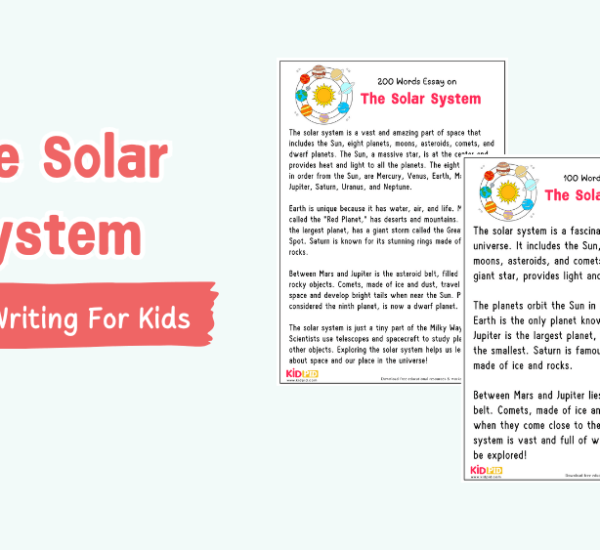Volcanoes are natural openings in the Earth’s surface that release molten rock, gases, and ash from deep inside. They can be destructive yet fascinating, shaping landscapes and influencing climate. This essay explains volcano types, causes, and effects, and includes helpful pointers and questions for better understanding.
10 Pointers About Volcano

- A volcano is a mountain with an underground molten rock pool.
- Pressure builds, forcing lava, ash, and gases to erupt.
- A volcano has a crater, a magma chamber, and a vent for lava.
- Active erupts, Dormant rest, and Extinct won’t erupt again.
- Magma inside Earth; outside, it’s called lava.
- Eruptions release fine rock particles that travel through the air.
- Famous volcanoes include Vesuvius, Mauna Loa, and Mount Fuji.
- Volcanoes give fertile soil, energy, and form new land.
- Lava, ash, and pyroclastic flows cause serious destruction.
- Scientists monitor volcanoes to help predict future eruptions safely.
Short Essay On Volcano
Essay On the Volcano in 100 Words

A volcano is a mountain that can erupt, spewing lava, ash, and gases. Inside the Earth, hot molten rock called magma builds up pressure until it bursts through the volcano’s opening, called a crater. When magma reaches the surface, it becomes lava. Some volcanoes are active (can erupt), some are dormant (sleeping), and others are extinct (will not erupt again). Volcanic eruptions can be dangerous, causing fires and ash clouds, but they also create fertile soil for farming. Famous volcanoes include Mount Vesuvius and Mauna Loa. Scientists study volcanoes to keep people safe from eruptions.
Essay On Volcano in 200 Words

A volcano is a fascinating yet powerful natural formation. It is essentially an opening in the Earth’s crust that allows molten rock (magma), ash, and gases to escape from below. When magma reaches the surface, it is called lava. Volcanoes are classified into three types: active (likely to erupt), dormant (inactive but may erupt in the future), and extinct (no longer erupting).
Volcanic eruptions can be both destructive and beneficial. On one hand, they can cause devastating lava flows, ash clouds, and even tsunamis. The eruption of Mount Vesuvius in 79 AD buried the city of Pompeii under ash. On the other hand, volcanoes create fertile soil ideal for farming and generate geothermal energy used for electricity.
Some of the world’s most famous volcanoes include Mauna Loa in Hawaii, the largest volcano on Earth, and Mount Fuji in Japan, a dormant volcano. Scientists called volcanologists study volcanoes using special tools to predict eruptions and warn people in time. While volcanoes are dangerous, they also shape our planet’s landscape and provide valuable resources.
Essay On the Volcano in 300 Words
Volcanoes are one of nature’s most powerful and awe-inspiring phenomena. They are openings in the Earth’s crust where magma (molten rock beneath the surface), gases, and ash erupt onto the land or into the air. When magma reaches the surface, it is called lava. Volcanoes are found both on land and underwater, often forming islands like Hawaii.
There are three main types of volcanoes: active (can erupt anytime, like Kilauea in Hawaii), dormant (not currently erupting but may in the future, like Mount St. Helens before 1980), and extinct (unlikely to erupt again). Volcanoes form due to the movement of tectonic plates—huge slabs of Earth’s crust that shift over time. When these plates collide or separate, magma can rise and create eruptions.
Volcanic eruptions can be extremely dangerous. Lava flows burn everything in their path, while ash clouds can block sunlight and disrupt air travel. Pyroclastic flows—fast-moving currents of hot gas and rock—are deadly. The 79 AD eruption of Mount Vesuvius destroyed Pompeii, preserving the city under ash. However, volcanoes also bring benefits. The ash and lava break down into nutrient-rich soil, perfect for farming. Geothermal energy from volcanoes provides clean electricity in countries like Iceland.
Scientists called volcanologists study volcanoes using seismographs, gas sensors, and satellites to predict eruptions. Early warnings help evacuate people and save lives. Famous volcanoes include Mauna Loa, the largest volcano on Earth, and Mount Fuji, Japan’s iconic dormant peak.
Despite their dangers, volcanoes play a crucial role in shaping Earth’s landscape. They create new land, provide resources, and remind us of our planet’s incredible power. Understanding volcanoes helps us prepare for eruptions and appreciate their role in nature.
Long Essay On Volcano in 500 Words
Introduction
A volcano is a rupture in the Earth’s crust that allows molten rock, ash, and gases to escape from beneath the surface. These geological formations are both destructive and creative, shaping landscapes and influencing climates. Volcanoes are found worldwide, often along tectonic plate boundaries, and their eruptions can have devastating or beneficial effects on the environment and human life.
Formation of Volcanoes
Volcanoes form when magma from the Earth’s mantle rises through cracks in the crust. This occurs primarily at tectonic plate boundaries, where plates collide or pull apart. The magma accumulates in a magma chamber and eventually erupts through a vent, forming a volcano. Over time, repeated eruptions build up layers of lava and ash, creating the familiar cone-shaped mountain. Some volcanoes, like those in Hawaii, form over hotspots—areas where magma rises from deep within the mantle.
Types of Volcanoes
There are three main types of volcanoes: shield, composite, and cinder cone. Shield volcanoes, such as Mauna Loa, have gentle slopes formed by flowing lava. Composite volcanoes, like Mount Fuji, are steep and built from layers of lava and ash. Cinder cone volcanoes, such as Paricutín, are small and formed from explosive eruptions that eject volcanic fragments. Each type varies in eruption style and danger level.
Effects of Volcanic Eruptions
Volcanic eruptions can have both harmful and beneficial effects. On the destructive side, they can cause loss of life, property damage, and climate change due to ash blocking sunlight. However, they also enrich soil with minerals, creating fertile land for agriculture. Additionally, geothermal energy from volcanoes provides a renewable energy source.
Famous Volcanoes Around the World
Some of the world’s most famous volcanoes include Mount Vesuvius, which destroyed Pompeii in 79 AD, and Krakatoa, whose 1883 eruption caused global temperature drops. Mount St. Helens in the U.S. erupted violently in 1980, while Iceland’s Eyjafjallajökull disrupted air travel in 2010. These eruptions remind us of the power and unpredictability of volcanoes.
Conclusion
Volcanoes are fascinating yet dangerous natural phenomena. They play a crucial role in shaping Earth’s geology and climate. While they pose risks to human life, they also provide valuable resources. Understanding volcanoes helps scientists predict eruptions and mitigate disasters, ensuring safer coexistence with these fiery giants.
FAQs on Volcano
Q1. What is a volcano?
Ans. A volcano is a mountain that lets out lava, ash, and gases from inside the Earth.
Q2. What is magma called once it reaches the surface?
Ans. It is called lava.
Q3. Name the three types of volcanoes based on activity.
Ans. Active, Dormant, and Extinct.
Q4. How do volcanoes form?
Ans. They form when magma rises through cracks in the Earth’s crust, usually at tectonic plate boundaries.
Q5. What are the three main types of volcano shapes?
Ans. Shield, Composite, and Cinder Cone volcanoes.
Q6. Name two harmful effects of volcanic eruptions.
Ans. Lava flows can destroy land, and ash clouds can block sunlight.
Q7. How can volcanoes be helpful?
Ans. They create fertile soil and provide geothermal energy.
Q8. What tools do scientists use to study volcanoes?
Ans. Seismographs, gas sensors, and satellites.
Q9. Name two famous volcanoes mentioned in the essays.
Ans. Mount Vesuvius and Mauna Loa.
Q10. Why is it important to study volcanoes?
Ans. To predict eruptions and help keep people safe.
Volcanoes are powerful natural formations that shape our planet’s surface. Understanding their causes, effects, and safety measures helps us respect nature’s strength while preparing for potential eruptions to protect lives and communities. To explore more, visit our website and get more paragraphs, essays, worksheets, flashcards, Quizzes, and other interactive resources. Make sure to follow us on YouTube & Facebook.
You might also like

Maya Lin (born October 5, 1959, in Athens, Ohio) is an American architect–artist renowned for her emotionally powerful Vietnam Veterans Memorial, blending simplicity, nature-inspired design, and public art while inspiring future generations.

Thomas Jefferson (born April 13, 1743 in Shadwell, Virginia) was the third U.S. president, primary author of the Declaration of Independence, doubled the nation via the Louisiana Purchase, and designed Monticello.

Malala Yousafzai (born July 12, 1997, in Mingora, Pakistan) survived a Taliban attack at 15, championed girls’ education globally, won the Nobel Peace Prize at 17, and co-founded the Malala Fund.

Michelle LaVaughn Robinson Obama (born January 17, 1964, in Chicago) served as First Lady (2009–2017), championed health with “Let’s Move!,” advanced education, penned the memoir Becoming, and continues inspiring globally.






